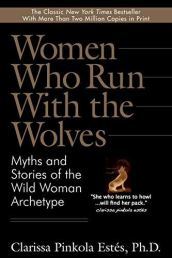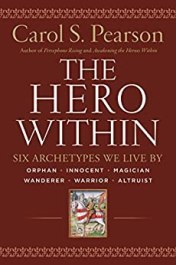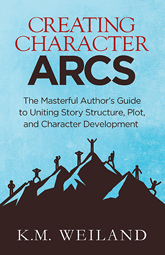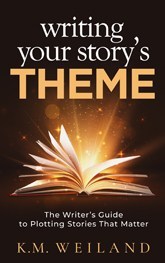Archetypal Character Arcs, Pt. 22: How to Use Archetypal Character Arcs in Your Stories
 And so we find ourselves (almost) at the end of a nearly six-month journey through the possibilities of archetypal character arcs. If you’ve stuck with me through what is by far the longest series I have ever shared, then I hope, like me, you are enthralled and excited by the possibilities that archetypes offer for bringing depth, resonance, and, yes, structure to your stories.
And so we find ourselves (almost) at the end of a nearly six-month journey through the possibilities of archetypal character arcs. If you’ve stuck with me through what is by far the longest series I have ever shared, then I hope, like me, you are enthralled and excited by the possibilities that archetypes offer for bringing depth, resonance, and, yes, structure to your stories.
But now what? Now that you’ve studied the six possible Positive Change Arcs within the archetypal life cycle, as well as the possible shadow devolutions and Flat resting periods, what do you do now? How can you apply these archetypal character arcs in a practical way to your own stories?
As with all of story theory, just by learning about archetypes, you have already osmotically collected tools and references that will likely show up naturally in your writing. Indeed, learning the specifics of archetypes only enhances what is already instinctive, since this intuitive understanding is the entire essence and point of archetype. From there, you can, of course, use these archetypes and their arcs to actively plan, plot, and write your stories. The structural beat sheets I provided for each of the Positive-Change “journeys” are a good place to get started if you’re wanting to apply any particular arc to your protagonist.
Today, let’s unofficially close out this series with a short discussion of the more practical side of applying archetypal character arcs to your stories. (Next week, we’ll officially end the series with a “master” summation post, listing the various comparative points of all the arcs and archetypes, so you can use it as an easy reference tool.)
Finding Your Own Character ArchetypesFirst of all, let me encourage you to make these archetypes your own. Don’t just take my word or the word of the many authors referenced in this series. Archetypes are resonant less because we mentally recognize them and more because we feel them. When we encounter a true archetype (or even just a subjective personal archetype), we feel the resonance deep within us.
When you experience this feeling, pay attention. You’ve almost certainly found something that matters to you and your life, and therefore probably something you should write about.
It’s important to realize that archetypes are not necessarily fixed. The system I’ve presented in this series—as one I personally resonate with—is not the only system. There are many more archetypes than the ones I’ve discussed here. Want a Trickster in your story, or a Femme Fatale, or a Warrior? These archetypes can be explored in their own specificity and mined for equally exciting and important stories.
If this discussion of archetypes has connected with you, then I highly recommend exploring the many books I’ve referenced throughout the series. A few are written specifically for writers; most are not. Most are written for people who are interested in the human experience and in finding leverage points in their own personal development. None of these books present the life-arc system exactly as I have, and almost all of them offer explorations of many different kinds of archetypes.
Here is a quick list of most of the books I’ve enjoyed on the subject (with affiliate links):
The Hero With a Thousand Faces by Joseph Campbell The Heroine’s Journey by Gail CarringerWomen Who Run With the Wolves by Clarissa Pinkola Estés The Virgin’s Promise by Kim Hudson Walking on Water by Madeleine L’Engle King, Warrior, Magician, Lover by Robert Moore and Douglas Gillette The Heroine’s Journey by Maureen Murdock Sacred Contracts by Caroline Myss The Hero Within by Carol S. Pearson Awakening the Heroes Within by Carol S. Pearson 45 Master Characters by Victoria Lynn Schmidt The Writer’s Journey by Christopher VoglerMore than just reading and studying archetypes, however, don’t be afraid to find them within yourself and your own experiences. Humans resonate with archetypes not because we find them outside ourselves, but because we recognize them as part of ourselves.

Women Who Run With the Wolves by Clarissa Pinkola Estes (affiliate link)
I will quote the wonderful Clarissa Pinkola Estés one last time:
Remember, Archetypal Character Arcs Are Developmental, But Not Always LinearI encourage people to do their own mining of story, for the scraped knuckles, the sleeping on cold ground, the groping in the dark and the adventures on the way are worth everything. There must be a little spilled blood on every story if it is to carry the medicine…. I hope you will go out and let stories happen to you.
Another important reminder is that although the archetypal system we have been studying these past months is presented in a linear fashion, it doesn’t have to be.
Unlike the theory of plot structure and general character-arc structure, these archetypal character arcs are not necessarily found in every story. They are not as strictly “episodic” in the sense that they should be told in a certain order and must be confined to one book at a time. The structures I’ve suggested for each Positive-Change archetype can be used for a single book, but it’s also possible (although of course more complicated) to utilize multiple archetypes within the single structural character arc of one book.

The Hero Within by Carol S. Pearson (affiliate link)
Although utilizing the archetypal character arcs in the order I’ve presented will make for a tidy, resonant, and sensible progression of character development—especially within a series—we all know real life isn’t always so tidy. In The Hero Within (which is specifically about real-life archetypal development), Carol Pearson puts it like this:
The hero’s journey is developmental, but not linear. No rule says that we all have to travel through it, lockstep, the same way others do. The trick is to understand the unique form and logic of your own particular journey. The circular diagram of the sacred wheel … is a two-dimensional model for a three-dimensional process. Actually, it would be more correct to envision it as a cone or spiral, in which it is possible to move forward while frequently circling back. Each stage has its own lesson to teach us, and we reencounter situations that throw us back into prior stages so that we may learn and relearn lessons at new levels of intellectual and emotional complexity.
This is also important to realize when studying archetypes in other stories. The examples won’t always be as clearly defined as they are for the more generalized character arcs that represent Positive-Change, Negative-Change, and Flat stories without specific archetypal grounding.
5 Considerations for How to Use Archetypal Character ArcsSo you’re ready to start writing epic archetypal stories? (I know I am!) What, then, are the best practices for applying these ideas to your own original works?

Creating Character Arcs (Amazon affiliate link)
First of all, remember that all of these archetypal character arcs are “built upon” the foundational theories and practices of story structure and character arcs. A solid understanding of these ideas will help you immensely in then layering the archetypes on top.
Second, don’t forget that archetypal language is deeply and purposefully symbolic. None of it needs to be literal. You can use all of the archetypes literally in a fantasy story if you wish, but you can also reach deep into the subtext of a hyper-modern and hyper-realistic story to find and utilize the same archetypes.
1. Identify Central Archetypes in Your StoriesThe first step is, of course, to figure out which archetypal arc you want to explore in your story. You can do this in one of two ways. Either you can simply choose to tell a story about a Maiden, a Sorceress, a Ruler, etc., and then start constructing a plot around these ideas. Or you can examine an idea you already have for a story and determine which archetypes are naturally present.
For example, in plotting sequels to my own fiction, I soon realized that the sequels were not (and could not be) another Hero Arc. The protagonist had already covered that ground and the sequels needed to progress the story. Realizing where the protagonist has already been is helpful in figuring out what comes next—and therefore which archetypes are likely to be the most accurate and useful.
2. Consider the Series as a WholeIf you’re writing a standalone story, your considerations will be fewer: you need only choose a single archetypal arc to work with. But if you’re writing a series, you can zoom out to consider the overall arc you will be telling over the course of multiple books.
The archetypal life arcs neatly lend themselves to serial fiction. If you wish to tell the entire life’s journey for a single character, you can easily do so by moving all the way through Maiden to Mage (with maybe some Flat-Arc books in there about the Lover, Parent, etc.).
If you know how large a story you intend to tell and where you want it to end up, you can better make room for all the necessary archetypal beats.
It’s also possible to utilize a single archetypal arc (such as the Hero Arc) across the entire series, interposing the beats appropriately from book to book.
The clearer you are on this in the beginning, the easier it will be to create the necessary depth and resonance (and save yourself a lot of hassle—trust me on this!).
3. Use Central Arcs to Choose and Flesh Out Supporting CharactersOnce you’ve identified the archetypal character arc your protagonist will be taking—and therefore the archetype that will define the story—you can also use this knowledge to help flesh out a thematically solid supporting cast.
If you know your protagonist will be following a Hero Arc, then you know your story will benefit from supporting characters who represent the progressed archetypes of the King and the Mentor or the Mage. If you’re writing a Queen Arc, you know your antagonist will have a double layer—both as the Invader who threatens the Kingdom and as the Puppet/Tyrant who must be replaced.
You’ll want to look for two particular types of supporting characters who can be represented archetypally:
1. Important Impact Characters, represented by Flat archetypes, who will know the thematic Truth your protagonist is trying to grasp—and therefore will be able to offer guidance.
2. Antagonists, who are symbolically important in all the Positive Arcs: Predator in the Maiden Arc, Dragon in the Hero Arc, Cataclysm in the King Arc, etc. (At the request of several of you, we will be exploring these archetypal antagonists in another series later this fall.)
4. Pay Attention to Inherent Archetypal Themes
Writing Your Story’s Theme (Amazon affiliate link)
The thematic possibilities within your specific and individual archetypal stories are vast. But it’s important to recognize that each archetype also offers inherent themes. To truly execute your personal themes well, you need to at least know what themes your chosen archetypes are also representing.
Within each of the previous posts in this series, I have discussed the “core” thematic Lie/Truth for each archetype. Although you may choose to raise these Truths differently or to riff off their manifold nuances, at least be aware of the message the central archetypes will share with readers simply by existing within your story.
5. Mine Your Own Archetypal ExperienceInevitably, our stories are stories of ourselves—whether our past, present, or future. So consider how your own journey through the life arcs might impact your stories.
As Pearson says:
The need to take the journey is innate in the species. If we do not risk, if we play prescribed social roles instead of taking our journeys, we may feel numb and experience a sense of alienation, a void, an emptiness inside. People who are discouraged from slaying dragons internalize the urge and slay themselves by declaring war on their fat, their selfishness, their sensitivity, or some other attribute they think does not please. Or they suppress their feelings in order to become successful performance machines. Or they become chameleons, killing off their uniqueness to serve an image they think buys success or just will keep them safe. When we declare war on our true selves, we can end up feeling as though we have lost our souls. If this goes on long enough, we are likely to become ill and have to struggle to get well. In shying away from the quest, we experience non life and, accordingly, we call forth less life in the culture. This is the experience of the wasteland.
Where do you think you are within the cycle? Your age can give you a clue. If you are chronologically within the First Act (roughly, the first thirty years), Second Act (thirty to sixty years), or Third Act (sixty to ninety-plus years), you may not necessarily be on a corresponding life arc, but you will very likely be at least experiencing its call. But, of course, life isn’t as neat as story theory, and you may be (like me) chronologically in your Second Act but still cleaning up loose ends from First-Act arcs.
Not only is this individual archetypal work transformative (personally and socially), it is also deeply insightful for applying archetypes to your writing. Once you can see how you have experienced your own Maiden Arc or Hero Arc, you will be able to tap a vast storehouse of wisdom and understanding in writing these journeys for your characters—even if their stories take place in outer space or long-ago historical eras.
I will end with one final challenge from Pearson, which I think speaks to the incredible potential offered to us by archetypes, both in our writing and in our lives:
Systems theory tells us that when any element of a system changes, the whole system has to reconfigure. Therefore, simply by experiencing your own metamorphosis, you can contribute to the transformation of all the social systems of which you are a part: family, school, workplace, community, and society as a whole.
Thank you so much for joining me on this journey! Next week, we will officially end the series with some summation, comparison, and a compilation of basic notes for easy future reference.
Related Posts:
Story Theory and the Quest for MeaningAn Introduction to Archetypal StoriesArchetypal Character Arcs: A New SeriesThe Maiden ArcThe Hero ArcThe Queen ArcThe King ArcThe Crone ArcThe Mage ArcIntroduction to the 12 Negative ArchetypesThe Maiden’s Shadow ArchetypesThe Hero’s Shadow ArchetypesThe Queen’s Shadow ArchetypesThe King’s Shadow ArchetypesThe Crone’s Shadow ArchetypesThe Mage’s Shadow ArchetypesIntroduction the 6 Flat ArchetypesThe ChildThe LoverThe ParentThe RulerThe ElderThe MentorWordplayers, tell me your opinions! Which archetypes are you most interested in writing about in your own stories? Tell me in the comments!Click the “Play” button to Listen to Audio Version (or subscribe to the Helping Writers Become Authors podcast in Apple Podcast or Amazon Music).
___
Love Helping Writers Become Authors? You can now become a patron. (Huge thanks to those of you who are already part of my Patreon family!)The post Archetypal Character Arcs, Pt. 22: How to Use Archetypal Character Arcs in Your Stories appeared first on Helping Writers Become Authors.




